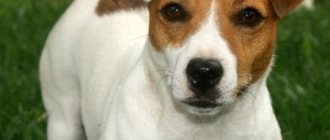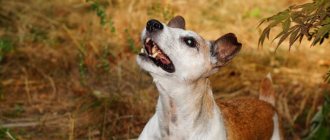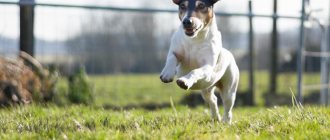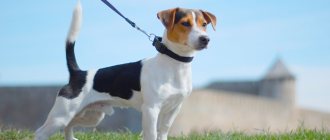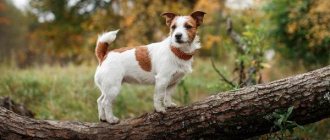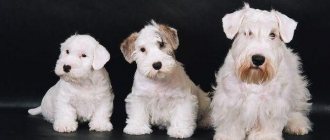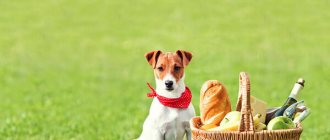Basics of the standard
The Jack Russell Terrier breed standard includes the following features:
- appearance and proportions;
- movements;
- appointment;
- character;
- dimensions: weight and height;
- head;
- body type;
- forelimbs;
- hind limbs;
- wool cover;
- color;
- flaws;
- vices.
Many owners, in addition to the basic parameters of the standard, are interested in the questions of how old these dogs grow and how long they live. The final development of the dog occurs between ten and twelve months. The average lifespan of an animal is sixteen years. But how long a dog will live largely depends on the quality of care and education. You can read more about this in the article “Raising and caring for a Jack Russell Terrier puppy.”
How to choose the right Jack Russell Terrier puppy
A potential buyer of a Jack Russell puppy, having started his search, should know that even if the dog is purchased “for the soul” and there are no plans for the pet to have a show career, it is not worth purchasing a baby without documents .
Each Jack Russell must have a document confirming its purebred. A purebred dog not only has a certain set of physical characteristics and a special temperament corresponding to the breed.
These qualities have been cultivated for several decades, and it is only thanks to their combination that the Jack Russell Terrier breed is so attractive and good.
A dog without documents may not grow up to look like a Jack, have a temperament that is not typical for the breed, or have a set of various genetic diseases. Why does the future owner need such a lottery if he wants to buy a cheerful, fearless and charming terrier? Large nurseries or a breeder who has one breeding bitch, when selling babies, must provide the buyer with all the documents he is interested in regarding the parents of the puppy . In addition, when selling a purebred dog, he has a puppy certificate, plus a veterinary passport.
The age of the baby also matters. You cannot buy a one-month-old puppy. According to the rules, puppies are certified by a livestock specialist and a club representative no earlier than forty-five days from the date of birth . After this, the baby is ready to go to a new family, but experienced breeders prefer to raise babies until they are two months or even three months old. Such a dog has already completed a course of vaccinations, shows his inherent character, and a knowledgeable person can easily determine how promising the baby is for exhibitions.
Experienced breeders know that in any litter, among the little Jacks, there are future stars and the most ordinary-looking puppies. Babies that are promising for exhibitions are sold at a higher price . When purchasing, you can ask the breeder what kind of puppy he can recommend, telling you about your expectations and preferences.
Important! Usually, families with small children, as well as beginners, are advised to buy female dogs, as they are calmer and gentler in character. Stubborn, leadership-prone males feel great with an owner who knows how to handle dogs.
How to choose the right puppy? You should not buy the largest baby in the litter.
When Jack Russell Terrier puppies grow up, they will all be approximately the same size; it is more important that the baby has the correct body proportions, bite, and temperament characteristic of the breed. There is no need to choose the smallest dog out of pity.
Too much lag in growth compared to littermates may indicate any problems in health or development.
A small Jack Russell should be cheerful and friendly, actively interested in guests and noisy with littermates. It is impossible to frighten him with a loud sound or confuse him with a new toy. Sitting quietly in a corner, not interested in new people, is either sick or a coward, which a Jack should not be .
In addition to the correct body proportions corresponding to the breed's temperament, the puppy must be absolutely healthy. A shiny coat, clear eyes and skin are signs of health. The baby should be normally developed for his age, have strong limbs, and be fairly well-fed.
Appearance
Active and resilient, the Jack Russell Terrier has a lithe, medium-length build and quick reflexes. For this expressive breed, having a heavy chest with undeveloped muscles is unacceptable.
A dog's coat has three types - smooth, hard and broken. The thick coat should be rough to the touch, but not too harsh, and should cope well with weather conditions.
At first glance at the rectangular body of the Jack Russell Terrier, it seems that the dog is growing in length, but not in height. From the chest to the withers of the animal there should be the same distance as from the elbow joint of the front paw to the ground. At the request of the dog owner, the tail can be docked, that is, some part can be removed.
Movements
The working characteristics of the breed allow the dog to move energetically and quickly. The Jack Russell Terrier's gait should feel free and confident. Due to its low weight and height, the dog can easily overcome obstacles.
Compliance with the standard can be determined when the dog walks without a leash. All movements of the Jack Russell Terrier should be natural and relaxed.
Care and maintenance
These dogs are completely unpretentious and do not require special care. It is enough to comb out dead hairs once a week so that they do not remain on pieces of furniture, and the dog’s coat is always shiny and well-groomed. You should also pay attention to trimming nails - the Jack Russell Terrier loves to dig. If they grow too long, it can become a problem for your floors and carpets.
Dogs of this breed are very active, so it is important to take time to walk them. If the time you spend outside is as active as possible, two half-hour walks a day are enough . During this time, it is important to tire the dog out as much as possible - this is a guarantee that the little energizer will not destroy your house.
Jack Russell Terriers are also unpretentious when it comes to feeding. A balanced diet would be ideal. Dogs of this breed are not prone to obesity, but, nevertheless, it is better to feed them strictly following a certain schedule. In addition to (or instead of) food, you can give them regular food, but in this case you need to make sure that the menu fully covers the dog’s body’s need for all nutrients.
Character
Discerning, cheerful and highly intelligent, the Jack Russell Terrier has a bold and energetic personality. Thanks to its bright features, this dog is easy to train. The education of this dog must begin from an early age, otherwise the animal’s stubbornness and aggressiveness may take over. It is necessary to be able to restrain the dog’s persistence so that he can learn to control himself.
Dog character and temperament
Its character also plays a significant role in a dog’s performance. Jack Russell Terriers have an unusually lively disposition. These are real actors in life and excellent companions for any company. The look of these dogs is distinguished by intelligence and intelligence. They are brave and fearless. But, at the same time, they are very friendly and trusting. Terriers of this type acutely sense a person’s mood, as well as the character of those who come to the owner’s house. And if the guest is inclined towards confidential communication and is a truly worthy person, then the Jack Russell Terrier will become an excellent companion for him and a tireless companion in various activities. This dog loves to learn training skills. She is so playful that she cannot sit still for even a few minutes. Therefore, the Jack Russell Terrier is suitable only for athletic and temperamental people, cheerful and loving long walks in nature, without which it is simply impossible to imagine the existence of terriers.
Dimensions
The height of a male Jack Russell Terrier should ideally be twenty-five to thirty centimeters; The minimum weight after the final development of the dog is five kilograms. An adult dog weighs no more than six kilograms.
The height of a female Jack Russell Terrier should be twenty-three to twenty-six centimeters, and its weight should also be up to six kilograms.
Calculating how much a dog weighs is very simple: for one kilogram of weight there are five centimeters of height. Accordingly, if an animal’s height is twenty-five centimeters, then its weight is five kilograms. If a dog is thirty centimeters tall, then its weight will be six kilograms.
Weight and dimensions
The ideal weight of a Jack Russell Terrier should not exceed 6-7 kg. The minimum weight for terriers of this variety should not be less than 5 kg. The height of the dog varies from 25 – 30 cm. At first glance at the Jack Russell Terrier breed, you may get the misleading impression that the dog is somewhat disproportionate and slightly stretched in length, which is somewhat different from its height. But such dimensions were created meaningfully and intentionally precisely so that the Jack Russell could perfectly vary his body at the time of hunting and professionally cope with his duties as a burrowing dog.
Head
According to the standard, a dog's skull of medium length should be flat, gradually tapering to powerful jaws. The transition from the muzzle to the forehead is well defined, but not too clearly defined.
The nose is black.
The Jack Russell Terrier's muzzle should look like this: the length from the stop to the back of the head with a characteristic bump should be slightly longer than the length from the nose to the stop. The proportion is five to two.
The dog's lips fit tightly to the muzzle with black pigmentation.
The dog's cheekbones should have well-developed muscles.
A scissor bite of a strong, wide, square jaw has a full set of powerful, healthy teeth. Teeth damaged as a result of hunting are not considered a defect and such a dog should not be fined. But a protruding jaw with poorly developed muscles is a defect.
Small almond-shaped eyes with fully closed eyelids have a dark shade and a soulful look. A bulging eyeball is a defect.
The Jack Russell Terrier's mobile and strong ears can be drooping or slightly raised on cartilage. The dog can turn them one hundred and eighty degrees. Prick ears are considered a defect according to the standard.
Well-developed neck muscles allow the dog to hold its head balanced. The length of the strong neck should correspond to a two to three proportion relative to the back of the animal. The neck is responsible for the balance of the entire body, so a neck that is too powerful, short or long is a defect.
Body type
According to the standard, the Jack Russell Terrier's body should be rectangular in shape with a flat back. The length from withers to tail is slightly longer than from ground to withers.
The short loin has well-developed muscles, since the ribs of the chest cannot withstand heavy loads.
A deep chest should have a small volume. In the middle of the distance from the ground to the withers of the animal there should be a clearly visible part of the chest. The volume of the ribs behind the elbows of the forelimbs is forty to forty-three centimeters. If you look at the dog from above, the chest should be visible from behind the shoulder.
The tail hangs down in a calm state; when the Jack Russell Terrier is excited, it becomes straight and takes on a vertical position. If the animal's tail has been docked - some part has been removed - its end should be at the level of the ears.
Hind limbs
The Jack Russell Terrier's strong hind legs are well-muscled. They maintain balance in proportions relative to the shoulder blades.
The hock joint stands at a comfortable angle relative to the ground and is located quite low.
If you look at the dog from behind when it is standing calmly, you will see that the metatarsus are parallel to each other.
Small, densely built, hind legs have soft pads. Toes turned inward or outward are considered a flaw.
Changing teeth in Jack Russell Terrier puppies
Despite the fact that Jack Russell Terrier puppies mature a little earlier than their larger counterparts, their teeth change at the usual time for all babies.
Already at the age of three and a half months, baby teeth, starting with the incisors, gradually fall out , and permanent teeth grow in their place. If you examine the puppy's mouth at this age, you will see that the front incisors have become very small or are absent altogether.
By four months, the incisors are replaced with permanent ones, the puppy’s canines and other milk teeth gradually become loose and begin to fall out.
It is important not to give the puppy calcium supplements until this time, otherwise changing teeth will be difficult, and the fangs will have to be removed at the veterinary clinic.
Removal of a primary fang is necessary if a new fang is already beginning to grow in its place. In this case, the row of teeth is disrupted, the permanent tooth may grow out of place, resting on the gum and injuring it. If the owner notices the growth of a new tooth, but the old one has not yet fallen out, then before visiting the veterinarian, you can try to loosen the baby teeth . To do this, use large raw beef bones, which the pet gnaws, or practice playing football using an old, deflated soccer ball. The baby, grabbing the ball, digs his teeth into it, painlessly loosening them.
At five months, little Jack's teeth are almost complete. By this age, premolars (small teeth immediately behind the canines) have erupted, and a normal scissor bite characteristic of the breed has already formed.




